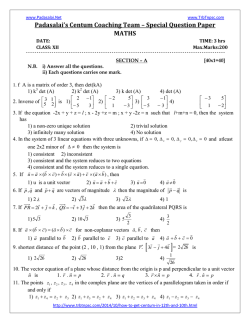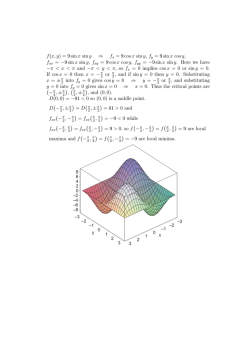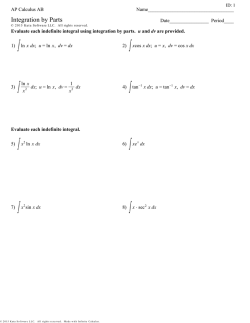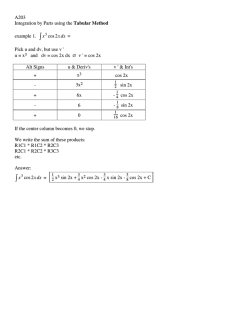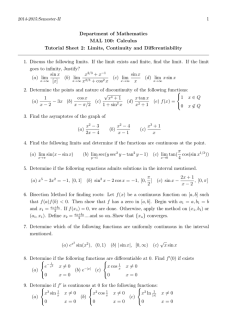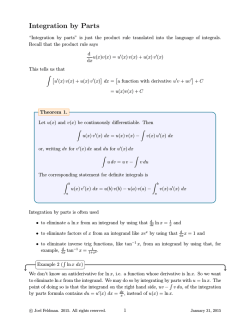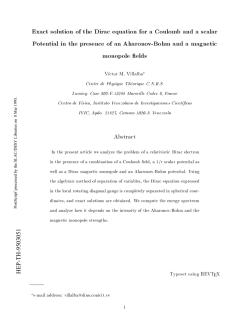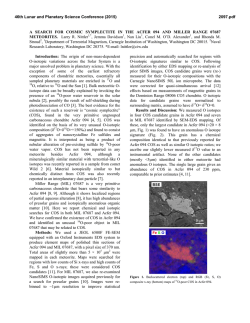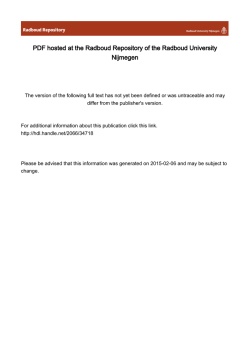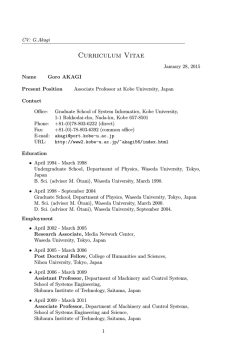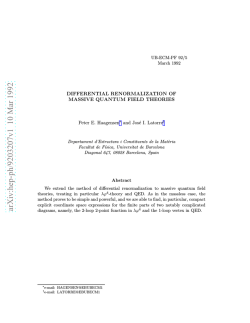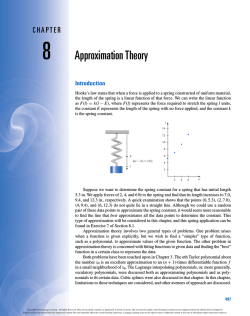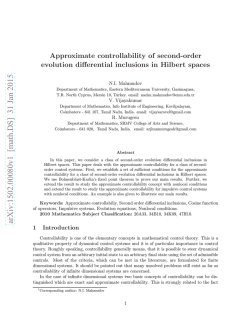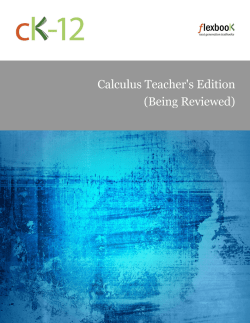
Homework solutions
Math 215 February 5, 2015 SOME SOLUTIONS TO THE HOMEWORK HW1 Note: All derivatives, y 0 , y 00 , u0 , u00 , are with respect to x. (1) Suppose that y is a function of x. Express the following in terms of x, y 0 and y 00 . d 2 (a) (y ) Answer: 2yy 0 dx d2 2 (y ) Answer: 2(y 0 )2 + 2yy 00 (b) dx2 d 2 (c) (x y) Answer: x2 y 0 + 2xy dx (2) Suppose that u is a function of x and y = ux2 . Express the following in terms of x, u0 and u00 . (a) y 0 Answer: x2 u0 + 2xu. This is Question 1(c) again. (b) y 00 Answer: x2 u00 + 4xu0 + 2u (3) Find all solutions of the following differential equations: (a) y 0 = 0 Answer: y = C with C a constant. (b) y 00 = 0 Answer: y = c0 + c1 x with c0 and c1 constants. (c) y 0 = x Answer: y = x2 /2 + C with C a constant. (d) y 00 = x Answer: y = x3 /6 + c0 + c1 x with c0 and c1 constants. (4) Consider the differential equation xy 0 − 2y = 0 with x > 0. (a) Suppose y = ux2 is a solution of the equation for some function u of x. Show that u0 = 0. Answer: From y = ux2 we get y 0 = x2 u0 +2xu. Hence xy 0 −2y = x(x2 u0 +2xu)−2x2 u = x3 u0 . Since x > 0, y = ux2 is a solution if and only if u0 = 0. (b) Using this fact, find all solutions of the differential equation. Answer: If u0 = 0, then u = C for some constant C, and hence y = x2 u = Cx2 is the general solution. (5) For what integers n is y = xn a solution of x2 y 00 + xy 0 − y = 0? Answer: If y = xn then y 0 = nxn−1 and y 00 = n(n − 1)xn−2 . Plugging these expressions into the differential equation we get x2 y 00 + xy 0 − y = x2 (n(n − 1)xn−2 ) + x(nxn−1 ) − y = (n2 − 1)xn . This is the zero function if and only if n2 − 1 = 0, that is, if n = ±1. HW2 (1) Verify that√the following functions are solutions of the corresponding differential equations. √ (a) y = 2 x + c, y 0 = 1/ x. √ Answer: Taking the derivative of both sides of y = 2 x + c gives y0 = √ d (2x1/2 + c) = x−1/2 = 1/ x. dx (b) y 2 = e2x + c, yy 0 = e2x . Answer: Taking the derivative of both sides of y 2 = e2x + c using the chain rule we get 2yy 0 = 2e2x , which simplifies to the given differential equation. 1 2 p d (c) y = arcsin xy, xy 0 + y = y 0 1 − x2 y 2 . Hint: arcsin x = sin−1 x and (sin−1 x) = dx 1 √ . 1 − x2 Answer: Using the chain rule, we first calculate the derivative of arcsin(xy) with respect to x: d dy d 1 1 y+x (arcsin(xy)) = p (xy) = p . dx dx 1 − (xy)2 dx 1 − (xy)2 Now suppose that y satisfies y = arcsin(xy). Taking the derivative of both sides of this equation we get the differential equation dy dy 1 y+x =p , dx dx 1 − (xy)2 which simplifies to xy 0 +y = y 0 equation. p 1 − x2 y 2 . Hence y is a solution of the given differential d (d) x + y = arctan y, 1 + y 2 + y 2 y 0 = 0. Hint: arctan x = tan−1 x and (tan−1 x) = dx 1 . 1 + x2 Answer: Suppose that y satisfies x + y = arctan y. Taking the derivative of both sides of this equation with respect to x using the chain rule we get the differential equation 1+ dy 1 dy = dx 1 + y 2 dx which simplifies to 1 + y 2 + y 2 y 0 = 0. Hence y is a solution of the given differential equation. (2) Use separation of variables to solve the following equations: (a) x5 y 0 + y 5 = 0 Answer: 1/y 4 + 1/x4 = C (b) y 0 − y tan x = 0 Answer: Rewrite as dy/y = tan x dx. Solution is y = C sec x. (c) (y + yx2 + 2 + 2x2 ) dy = dx Answer: y 2 /2 + 2y = tan−1 x + C (d) y 0 /(1 + x2 ) = x/y and y = 3 when x = 1. Answer: The general solution of the differential equation is 2y 2 = 2x2 + x4 + C. The solution such that y = 3 when x = 1 is 2y 2 = 2x2 + x4 + 15. (e) y 0 = x2 y 2 and the graph of the solution passes through (−1, 2). Answer: −1/y = x3 /3 − 1/6 dy (3) The differential equation 2y = x2 + y 2 − 2x is not separable. Supposing that y is a soludx tion of this equation, show that v = x2 + y 2 is a solution of a separable differential equation. Use this fact to find all solutions of the original differential equation. dy dv Answer: First we find the relationship between and by differentiating v = x2 + y 2 : dx dx dv d 2 dy = (x + y 2 ) = 2x + 2y . dx dx dx dv = v. This separable equation dx x 2 2 for v has solutions √ v = Ae where A is a constant. From this equation and v = x + y we x 2 find that y = ± Ae − x , with A > 0, are all solutions of the original differential equation. Plugging this into the original differential equation gives 3 HW3 (1) Solve the following differential equations. Some are separable, some are linear, some are both. If possible, express y as a function of x. dy (a) x3 − 3y − x =0 x>0 dx 3 dy + y = x2 . So P = 3/x and Q = x2 . Answer: Linear when written in the form dx x R R R We have P dx = 3 ln x = ln x3 , so H = e P dx = x3 . Finally y = H −1 HQ dx = R x−3 x5 dx = x−3 (x6 /6 + C) = x3 /6 + Cx−3 dy = 2e2x dx Answer: linear: y = (C + e2x )/x (b) y + x dy = y2 x>0 dx √ √ Answer: separable: y = x/(6x2 + C x + 2) (c) 9x2 y 2 + x3/2 (d) (e) dy x = such that y = −1 when x = 0 dx y−1 √ Answer: separable: y = 1 − x2 + 4 dy − 2xy = x such that y = 1 when x = 0 dx 2 2 Answer: linear: integration factor= e−x ; y = (3ex − 1)/2. (f) y dx + (xy 2 + x − y) dy = 0. Hint: Think of x as a function of y. Answer: The trick here is to think of x as a function of y. The given equation can be written as dx 1 + y+ x=1 dy y so we set P (y) = y + Z 1 P (y) dy = y 2 + ln y 2 1 and Q(y) = 1. Then y H(y) = e The implicit solution is x = Ce−y 2 /2 R P dy y 2 /2 = ye Z H(y)Q(y) dy = ey 2 /2 + C. 1 2 (ey /2 + C) which can be simplified to xy = 1 + yey2 /2 . (2) Show that if y is a solution of dy √ + P (x) y = Q(x) y dx then v = √ y is a solution of a first order linear equation. dv 1 dy 1 dy √ Answer: From v = y, we get = √ = . Substituting this into the differential dx 2 y dx 2v dx dv equation yields 2v + P (x) v 2 = Q(x)v, which becomes linear after dividing by 2v. dx 4 HW4 (1) Solve the following differential equations. All are exact—perhaps after a bit of algebraic manipulation. dy (a) (2xy 2 + 2y) + (2x2 y + 2x) = 0 Answer: Exact: x2 y 2 + 2xy = C. dx y + 6x dx + (ln x − 2) dy with x > 0. Answer: Exact: y ln x + 3x2 − 2y = C. (b) x (c) ax + by dy = − with a, b, c, d constants. Answer: This is exact if written as (bx + dx bx + cy cy) dy + (ax + by) dx = 0. Solution is ax2 + 2bxy + cy 2 = C. (d) (y 2 + xy) dx − x2 dy = 0. Hint: Multiply this equation by the integration factor 1/(xy2 ) to make it exact. Answer: Multiplying by 1/(xy 2 ) gives the exact equa 1 x 1 x + tion dx − 2 dy = 0 with solution + ln |x| = C. x y y y dy (e) cos y sin x + 2 sin y cos x = 0. Hint: Multiply this equation by the integration facdx tor sin x to make it exact. Answer: Multiplying by sin x gives the exact equation dy sin2 x cos y + 2 sin x cos x sin y = 0 with solution sin2 x sin y = C. dx (2) Solve the following differential equations. Whenever possible, express y as a function of x. dy − y = 2e2x Answer: Linear: y = 2e2x + Cex (a) dx √ dy (b) y +x=0 y(0) = −3 Answer: Separable: y = − 9 − x2 dx (c) (d) dy y y2 y = + 2 x>0 Hint: Find a differential equation satisfied by u = . Start dx x x x by differentiating xu = y to get an equation relating u0 to y 0 . Answer: Differentiating xu = y, gives u + xu0 = y 0 . Plugging this into the differential equation yields the separable equation xu0 = u2 , with solution u = −1/(ln x + C). Finally y = xu = −x/(ln x + C). dy = 2xy 2 dx y(0) = 1 Answer: Separable: y = 1/(1 − x2 ). (e) (cos x)y 0 = (sin x)y Answer: Written as (cos x) dy − (sin x)y dx this equation is exact. 1 Solution is y cos x = C or y = C sec x. This equation is also separable, dy = tan x dx, y with the same solution. dy (3) The equation cos y sin x + 2 sin y cos x = 0 from Question (1e) is separable. Use this fact dx to solve the equation. Answer: Separating the variables we get cot y dy = −2 cot x dx, and then integration gives ln | sin y| = −2 ln | sin x| + C. This implies sin y = ±eC (sin x)−2 , or sin y sin2 x = C1 where now C1 = ±eC is an arbitrary constant. (4) Show that every separable first order differential equation is exact. Answer: A separable equation is one that can be written in the form M (x) dx = −N (y) dy for certain functions M (x) and N (y). The important point is that M is a function of x only and N is a function of y only. This equation can be written as M (x) dx + N (y) dy = 0 which ∂N ∂M is exact because = 0 and = 0. ∂y ∂x 5 HW5 In a leaking water tank, the height of water h is a decreasing function of time t. Using Torricelli’s Law, we derived in class the differential equation satisfied by h: p dh A = −a 2gh dt 2 where g is the acceleration of gravity (9.8 m/s ), a is the area of the hole through which the water is leaking and A is the area of the the surface of the water at height h. In class we assumed that the tank was a vertical cylinder and so A is constant in h. Even so, the differential equation is valid even if A is a function of h. This happens, for example, if the tank has the form of a paraboloid with area A0 at the top and height H. Then the surface area of the water A as a function of the height of the water in the tank varies linearly from h = 0 (where A = 0) to h = H (where A = A0 ): A0 h. H Suppose that the tank is full (h = H) at t = 0. At what time is the tank empty? Answer: Combining the two equations above we get p dh A0 h = −a 2gh H dt A= and separating variables h and t, √ h dh = − aH p 2g dt. A0 Integrating gives 2 3/2 aH p 2g t + C. h =− 3 A0 We choose C = 32 H 3/2 so that the tank is full (i.e. h = H) at t = 0: 2 3/2 aH p 2 h =− 2g t + H 3/2 . 3 A0 3 This is the implicit solution of the differential equation satisfying the condition that h = H when t = 0. Now we find the time at which the tank is empty by setting h = 0 and solving for t. This gives s t= 2A0 3a H . 2g HW6 Solve the following differential equations. (1) y 00 = 3y 0 Answer: y = c1 + c2 e3x (2) y 000 = y 0 Answer: Auxiliary equation: m3 − m = m(m − 1)(m + 1). General Solution: y = c1 + c2 ex + c3 e−x (3) 2y 00 + y 0 − 6y = 0 Answer: y = c1 e−2x + c2 e3x/2 (4) (4D2 − 4D + 1) y = 0 Answer: The auxiliary equation 4m2 − 4m + 1 = (2m − 1)2 = 0 has the double root m = 1/2. Thus the solution is y = (c1 + c2 x)ex/2 . (5) 4y 000 = 3y 0 + y Answer: The auxiliary equation is 4m3 − 3m − 1 = 0 which factors as (m − 1)(2m + 1)2 = 0, so it has the double root m = −1/2, as well as the simple root m = 1. Thus the solution is y = (c1 + c2 x)e−x/2 + c3 ex . 6 (6) dy d2 y +4 + 4y = 0 with initial conditions y(0) = 1 and y 0 (0) = 1. Answer: General dx2 dx Solution: y = (c0 + c1 x)e−2x . Particular Solution: y = (1 + 3x)e−2x . (7) (D2 − 4)2 y = 0 Answer: Auxiliary equation: (m2 − 4)2 = 0. Roots: m = ±2 are double roots. General Solution: y = (c1 + c2 x)e2x + (c3 + c4 x)e−2x (8) D3 y = 0 y(0) = 0, y 0 (0) = 1. Answer: Auxiliary equation: m3 = 0. Roots: m = 0 is a triple root. General Solution: y = c0 + c1 x + c2 x2 . The condition y(0) = 0 implies c0 = 0, and then the condition y 0 (0) = 1 implies c1 = 1. The remaining constant c2 is still arbitrary. Final answer y = x + c2 x2 . HW7 (1) Solve the following differential equations. (a) y (4) + y 00 = 0 Answer: The auxiliary equation factors as (m − i)(m + i)m2 and so y = c1 + c2 x + c2 cos x + c4 sin x. (b) (D3 −5D2 +9D−5)y = 0 Answer: Auxiliary equation: m3 −5m2 +9m−5 = (m−1)(m2 − 4m + 5); Roots: m = 1, 2 ± i. General Solution: y = c1 ex + c2 e2x cos x + c3 e2x sin x. dy d2 y −2 + 5y = 0 Answer: y = ex (c1 cos 2x + c2 sin 2x). dx2 dx (d) (D2 − 4D + 20) y = 0 with initial conditions y(π/2) = 0 and y 0 (π/2) = 1. Answer: General solution y = e2x (c1 cos 4x + c2 sin 4x). Particular solution: y = 41 e2x−π sin 4x. (c) d2 y dy + 32 + 25y = 0 y(0) = 0, y 0 (0) = 1. Answer: Auxiliary equation: 16m2 + 2 dx dx 32m + 25 = 0. Roots: m = −1 ± 43 i. General Solution: y = e−x (c1 cos 34 x + c2 sin 43 x). The condition y(0) = 0 implies c1 = 0, and then the condition y 0 (0) = 1 implies c2 = 43 . Final answer y = 43 e−x sin 34 x. (2) Suppose the function y satisfies the differential equation (e) 16 y 00 + Ky = 0 for some constant K. dE (a) Show that the function E = (y 0 )2 + Ky 2 is constant. Hint: Calculate . dx dE Answer: = 2y 0 y 00 + 2Kyy 0 = 2y 0 (y 00 + Ky) = 0. Hence E is a constant function. dx (b) Derive the general solution for the differential equation and confirm that E is constant by direct calculation from your solutions. Note that the general solutions will have a different form depending on whether K > 0, K = 0 or K < 0. Answer: • If K = −r2 < 0, then y = c1 erx + c2 e−rx and E = −4c1 c2 K. • If K = ω 2 > 0, then y = c1 cos ωx + c2 sin ωx and E = (c21 + c22 )K. • If K = 0, then y = c1 + c2 x and E = c22 . In each case E is a constant. HW8 d2 Q dQ 1 In class we discussed the differential equation L 2 + R + Q = 0. We set ρ = R/2L and dt dt C √ d2 Q dQ ω0 = 1/ LC which simplified the equation to + 2ρ + ω02 Q = 0, and then we found the dt2 dt general solution in the case that ρ < ω0 . (1) Find the general solution of this differential equation in the case that ρ = ω0 . Answer: Setting ρ = ω0 , the differential equation becomes (D2 + 2ρD + ρ2 )Q = 0 with auxiliary equation m2 + 2ρm + ρ2 = (m + ρ)2 = 0. So m = −ρ is a double root and the 7 general solution is Q = (c1 + c2 t)e−ρt . (2) Find the general solution of this differential equation in the case that ρ > ω0 . Answer: The roots of the auxiliary equation are the (negative) real numbers q m = −ρ ± ρ2 − ω02 and the general solution is √ 2 2 √ 2 2 Q = c1 e(−ρ+ ρ −ω0 )t + c2 e(−ρ− ρ −ω0 )t . 1 2 (3) The energy stored in the capacitor is EC = Q . The energy stored in the inductor is 2C dQ 1 . The resistor does not store energy — it absorbs electrical EL = LI 2 . Reminder: I = 2 dt energy and gives off heat. Show that the total energy, E = EC + EL . satisfies dE = −RI 2 . dt This means that the total energy is a decreasing function of time. Answer: 2 ! dE d 1 2 1 dQ = Q + L dt dt 2C 2 dt dQ d2 Q 1 dQ Q +L C dt dt dt2 dQ 1 d2 Q = Q+L 2 dt C dt dQ dQ = −R = −RI 2 dt dt = Here we are using, of course, L dQ 1 d2 Q +R + Q = 0. dt2 dt C HW9 (1) Find the general solutions of the following differential equations. (a) y 00 + y 0 − 2y = 2x. Answer: y = − 12 − x + c1 ex + c2 e−2x (b) y 00 + 2y 0 = 3 + 4 sin 2x Answer: y = c1 + c2 e−2x + 21 (3x − sin 2x − cos 2x) (c) (D − 1)y = sin2 x. Hint: Linear combinations of sin2 x and its derivatives look like yp = A + B sin2 x + C sin x cos x (Check this). Alternatively, using a trig identity, rewrite sin2 x as a function of cos 2x. Answer: Suppose that yp = A + B sin2 x + C sin x cos x. Then (D − 1)yp = −A + C cos2 x + (2B − C) cos x sin x − (B + C) sin2 x = −A + C + (2B − C) cos x sin x − (B + 2C) sin2 x. So that yp is a solution, we want −A + C = 0, 2B − C = 0 and −(B + 2C) = 1. These equations imply B = −1/5, A = C = −2/5, and so the general solution is 2 1 2 y = − − sin2 x − sin x cos x + c1 ex . 5 5 5 OR 8 Since sin2 x = 12 (1 − cos 2x), we try yp = A + B cos 2x + C sin 2x. Then (D − 1)yp = −A + (2C − B) cos 2x + (−2B − C) sin 2x. So that (D−1)yp = 21 (1−cos 2x), we want −A = 1/2, 2C −B = −1/2 and −2B−C = 0. These equations imply A = −1/2, B = 1/10 and C = −1/5, and so the general solution is 1 1 1 y=− + cos 2x − sin 2x + c1 ex . 2 10 5 (d) y 00 − y = ex . Answer: y = 12 xex + c1 ex + c2 e−x (e) y 00 + ω02 y = cos ω0 x where ω0 6= 0 is constant. Answer: y = c1 cos ω0 x + c2 sin ω0 x + 1 x sin ω0 x 2ω0 (2) Let u and v be functions of x that satisfy u0 = xv and v 0 = xu. Find second order linear differential equations satisfied by u and v separately. Answer: Differentiating u0 = xv gives u00 = v + xv 0 . Then, since v 0 = xu and v = u0 /x, we get u00 = u0 /x + x(xu). Clearing denominators, this can be written as xu00 − u0 − x3 u = 0. By symmetry, v satisfies the same differential equation: xv 00 − v 0 − x3 v = 0. (3) Suppose that yp is a solution of (D3 + 2D2 + D + 3)y = 0. Find a differential equation satisfied by yp0 . Hint: Don’t try to solve the differential equation! Differentiate it. Answer: Differentiating the given equation gives (D4 + 2D3 + D2 + 3D)y = 0 or (D3 + 2D2 + D + 3)(Dy) = 0, so, if yp satisfies the given differential equation, Dyp satisfies the same differential equation. d2 y dy dy −x 2 =0 x > 0. Hint: Let u = . What differential equation does (4) Solve x3 − 3 dx dx dx u satisfy? HW3(1a). du dy Answer: u satisfies x3 − 3u − x = 0, so from HW3(1a), u = x3 /6 + Cx−3 and = dx dx x3 /6 + Cx−3 . Integrating the last equation gives y = x4 /24 − Cx−2 /2 + B where C and B are constants. HW10 Find particular solutions of the following differential equations using the method of undetermined coefficients. 1 2 x − x ex (1) y 00 − y = xex Answer: yp = 4 1 (2) y 00 + y = 2 sin x cos x Hint: Use trigonometric identity first. Answer: yp = − sin 2x 6 1 2 (3) y 00 + y = 2x sin x cos x Hint: Ditto. Answer: yp = − x sin 2x − cos 2x 6 9 1 00 2 (4) y + y = 2x sin x Answer: yp = −2x cos x + 2x sin x 4 1 (5) y 000 − y 00 = x3 Answer: yp = − x2 x2 + 12 4 HW11 (1) Find particular solutions of the following differential equations using the operator method. 1 1 1 (a) y 00 − 4y = e3x Answer: yp = 2 e3x = 2 e3x = e3x D −4 3 −4 5 (b) y (4) = e3x Answer: yp = 1 3x 1 1 3x e = 4 e3x = e 4 D 3 81 (c) y 00 − 4y = e2x Answer: yp = D2 1 1 1 1 1 1 1 1 e2x = e2x = e2x = e2x · 1 = xe2x . −4 D−2D+2 4D−2 4 D 4 9 (d) y 0 − 2y = xe2x Answer: yp = 1 1 1 1 xe2x = e2x x = e2x x = x2 e2x . D−2 (D + 2) − 2 D 2 (e) y 00 − 4y 0 + 4y = xe2x 1 1 1 1 Answer: yp = xe2x = e2x x = e2x 2 x = x3 e2x . 2 2 (D − 2) ((D + 2) − 2) D 6 (f) y 00 − 4y = cos x Answer: yp = 1 1 1 cos x = cos x = − cos x D2 − 4 −1 − 4 5 (g) y 00 − 4y = e2x cos x Answer: 1 1 1 yp = 2 e2x cos x = e2x cos x = e2x cos x D −4 (D + 2)2 − 4 (D + 4)D 1 D−4 1 = e2x sin x = e2x 2 sin x = e2x (D − 4) sin x D+4 D − 16 −17 1 2x 1 = e2x (cos x − 4 sin x) = e (4 sin x − cos x) −17 17 (2) Consider the differential equation (D2 − 1)y = x4 . (a) Find a particular solution of this equation using the method of undetermined coefficients. Answer: The complementary solution is yc = c1 ex + c2 e−x so we are in Case 1. We guess that yp = Ax4 + Bx3 + Cx2 + Ex + F for some constants A, B, C, E, F . (Don’t want to use D to represent a constant!) Then (D2 − 1)yp = −Ax4 − Bx3 + (12A − C)x2 + (6B − E)x + 2C − F. So that (D2 − 1)yp = x4 holds we need that A = −1, B = 0, C = −12, E = 0, and F = −24. Thus yp = −x4 − 12x2 − 24. (b) Find a particular solution of this equation using operator methods. Hint: You will need 1 the infinite series expansion of 2 . D −1 2 Answer: Plugging x = D in the expansion 1 = 1 + x + x2 + x3 + x4 + x5 + · · · 1−x we get 1 1 =− = −1 − D2 − D4 − D6 − D8 − · · · 2 D −1 1 − D2 so 1 x4 = (−1 − D2 − D4 − D6 − D8 − · · · )x4 yp = 2 D −1 = (−1 − D2 − D4 )x4 = −x4 − 12x2 − 24.
© Copyright 2025
